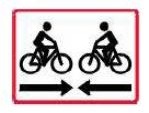Denmark is a very cycle friendly country and has a wide and extensive network of cycle routes, both national and regional. There are cycle paths along most major roads and in most towns. These paths are good to ride on (mostly asphalt) and well maintained. There are even old railway lines which have been transformed into cycle paths. The country is mainly flat with some low hills regions.
The roads and bicycle paths are well sign-posted, showing place names and distances in kilometres. The scenic roads do not always take you over the shortest distance from one place to another, but are definitely the most beautiful routes. Cycling is safe, also because of the high level of consideration most motorists give to cyclists. Cycle shops and repair facilities are widely available, although sometimes you may have to go to the more specialised shops in larger towns.
Doing a cycle tour with children on flat terrain in Denmark is surprisingly easy and enjoyable. It is safe (no speedy downhill parts), predictable and also matches their levels of stamina. In Denmark many children cycle for an organised family day out or for a longer vacation. On their own bike or safe in a bike seat or bike trailer or on their tagalong. Especially the island of Bornholm is a safe an attractive destination for cyclist.
Climate
Denmark is blessed with a mild maritieme climate. This is because of the position of the country on the edge of the European continent and close to large areas of sea with their prevailing westerly winds. This results in cool summers, and though the winters are not particularly cold. April till October is the best period for a cycling tour. There is a good deal of wind, with the strongest in the winter and gentles in the summer. Rain falls throughout the year, with the greatest amount falling in September, October and November. The lowest rainfall occurs from April to mid June. June, July and August are usuallly warm and tend to be the sunniest.
Traffic rules for cyclists
According to the Danish traffic law, bicycles sometimes have their own special regulations. These may differ from those for motorized traffic.
-
When making a crossing (with equal priority), the traffic coming from the right always has the right of way. The 'right of way' rules do not distinguish between 'slow traffic' (bicycles, mopeds, etc.) and 'fast traffic' (motorcycles and cars etc.).
-
Traffic turning off a main road must always give way to the traffic continuing along that road. This also means that cars turning right have to give priority to bikes (on their ‘inside’) going straight on.
-
Cyclists are not allowed on motorways.
-
Cycling against one-way traffic on the road is permitted if this is indicated by a secondary sign underneath.
-
Cycling side by side (max. 2 persons) is permitted provided that other road-going traffic is not inconvenienced.
-
Changing direction is indicated by putting your arm out in the desired direction.
-
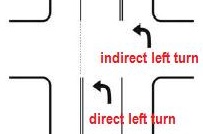 When making a left turn you must always make a "wide" left turn. Stay to the right side of the road, cross to the opposite corner, and wait until the road is clear before continuing in the new direction. (see figure). You do not have to wait for a green light in the new direction, but it is off course essential that the road is clear.
When making a left turn you must always make a "wide" left turn. Stay to the right side of the road, cross to the opposite corner, and wait until the road is clear before continuing in the new direction. (see figure). You do not have to wait for a green light in the new direction, but it is off course essential that the road is clear. -
On roundabouts you should yield on entry. Going around the motorists who want to leave the roundabout (or circle) should give way to cyclists who stay on the roundabout.
Traffic signs for cyclists
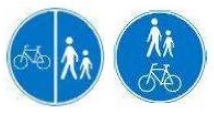
Combined mandatory bicycle path or bicycle lane
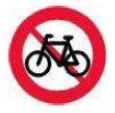
Cyclists prohibited
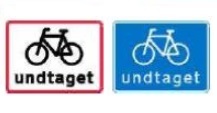
Except for cyclists at head sign "One way street"
Warning for crossing cyclists in both directions
Road signs
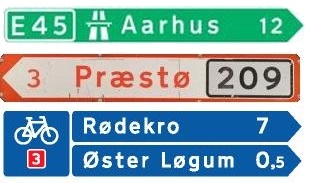 Both roads and cycle routes in Denmark are systematically numbered which makes navigating very relaxing. The typical bicycle signs are blue with red numbers. Distances are in kilometres. A cycle computer/odometer, calibrated in kilometres, is also very useful for longer tours when you need to work out the distance travelled on maps and at road signs.
Both roads and cycle routes in Denmark are systematically numbered which makes navigating very relaxing. The typical bicycle signs are blue with red numbers. Distances are in kilometres. A cycle computer/odometer, calibrated in kilometres, is also very useful for longer tours when you need to work out the distance travelled on maps and at road signs.
Safety
Helmets
There is no legal obligation to wear a helmet in everyday cycling, only in organised racing competitions. In everyday –flat terrain- cycling helmets are rarely worn (except for young children), as most people have a style and speed of cycling where such is, or thought to be less necessary.
Lightning
A (white bulb) head and (red bulb) tail-light are compulsory after dark.
Bicycle theft
Like everywhere else in the world, in Belgium there is bicycle theft. A good cable– or chain lock is highly recommended. Some towns have secure parking facilities for bicycles at railway stations and shopping centres. Remember the motto: “If you’re not riding your bike; lock it”.
Liability
In Belgium objective liability applies, which means that in a collision between a motorized vehicle and a cyclist, the insurance of the motorized vehicle always has to pay. The courts give separate judgements concerning liability and guilt in such situations. Thus, cyclists remain responsible for their own traffic-behaviour. They can be fined for traffic violations and if their traffic behaviour has further consequences, then the judge is at liberty to pass sentence on them.

